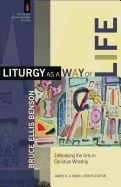Following up on Monday’s opening review of Bruce Ellis Benson’s Liturgy as a Way of Life by Ed Phillips, Bruce offers his response below.
below.
—————-
First, I want to thank Ed Phillips for such a thoughtful response to my book. It’s always a pleasure to respond to reviewers who have interacted with one’s work at a serious level. I’m delighted to address his questions.
Regarding question two, I think we have to say that St. Gregory of Nyssa Episcopal Church is a phenomenon that can’t really be duplicated. But I’m delighted about that! The Methodist church in your hometown shouldn’t be trying to be like it; instead, the parishioners should ask: how should we, as a community in Linden, Tennessee, worship God in ways that will speak to people in Linden (not “how can we be like St. Gregory of Nyssa?”)? In terms of the larger question—the concern about “decontextualized, commodified culture,” I think we can say the following: the church has been borrowing or (to use my terminology) improvising upon cultural practices since its inception. I think it’s safe to say that all Christian practices are “recontextualized” forms adopted from elsewhere. Someone looking at St. Gregory of Nyssa from the outside could well see its practices as “multicultural bricolage,” but isn’t this true of any church? The difference is that we don’t “see” it for the bricolage that it is because it is so “normal.”
Let me turn to question three. There are many different formulations of the idea of “panentheism.” The function of the passage Ed cites (pp. 72-76) is first and foremost to deconstruct the demi-god status of the romantic artist who creates seemingly out of nothing. My point is that human beings are not like God in that they create out of something. Whether the Genesis account of creation is one that can be read as “improvisatory” is one that I leave open. In any case, creatio ex improvisatio, like creatio ex nihilo, clearly recognizes God as a distinct being from the world. Even so, the question is founded on the presupposition that the question in Genesis is firstly ontological, whereas my claim (along with Walton) is that the question to which Genesis is an answer is primarily one of order. While it is true that claiming creation is constituted by improvisation implies God’s constant and current work in the world as part of that improvisatory movement, the distinction made here between God and the created is not incompatible with “traditional” theism. In some ways, it is a preservation of both ontological separation and interaction.
Finally, I’m delighted that Ed took the time to read Kant! That’s probably an achievement on its own. As to the universality of aesthetic judgment, here is the problem. Kant wants to say there should be a universal agreement regarding the beauty (or lack thereof) of a given object. However, he thinks that this universality is in no way grounded in the thing under consideration. Instead, it is purely “subjective” in the sense of depending only upon the subject and not the object. I find that sort of belief dubious, at best. Moreover, it forces Kant to insist that people should agree with him (that’s the fascist part). I do think that Kant is trying to account for some kind of universality in our aesthetic judgments. But, and this is a point that cannot be overemphasized, Kant has taken away the resources to make this a reality. For instance, he thinks that art should not be judged by way of its function. Yet much art we deem good or bad on the basis of its intended purpose. Music designed for listening to over dinner is really different from Wagnerian opera. One can be just “as good” as the other, but for different purposes. To put this another way, there is no such thing as “pure beauty” disconnected from life in the way that Kant thinks there is. One last thing: I think there is more agreement possible about good and bad art than people in our age tend to think. When I was a student in Germany, a large group of the “foreign students” attended the Egyptian museum in Berlin together. We were uniformly impressed by the singular beauty of the bust of Nefertiti, an artifact from another age and from none of our cultures. I think this is much more often the case than we realize.